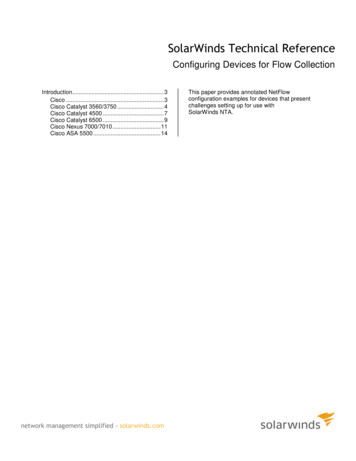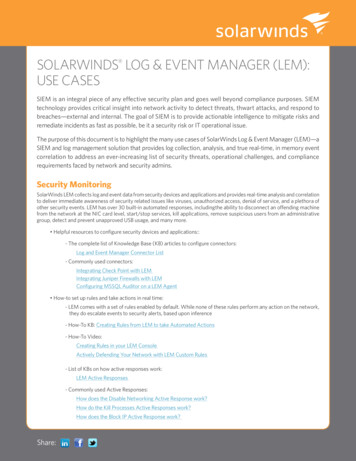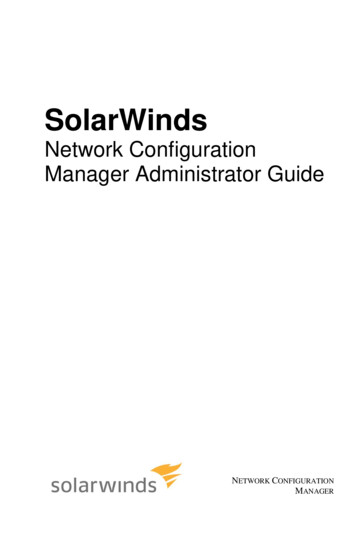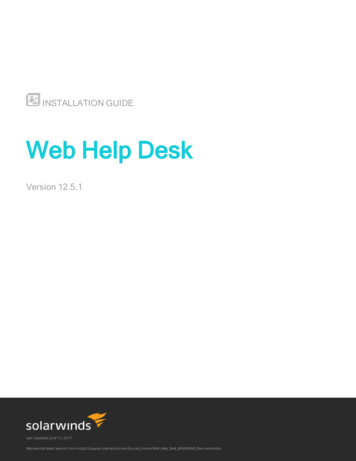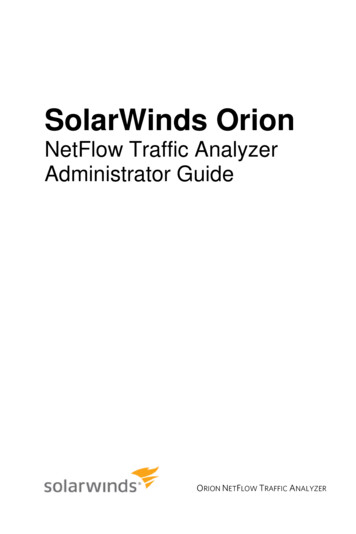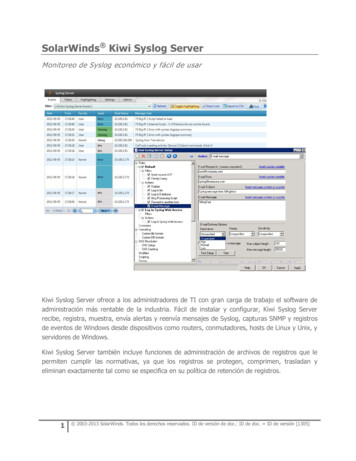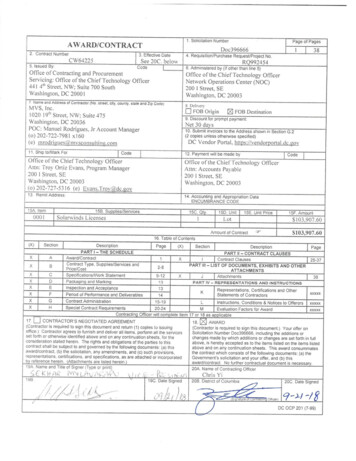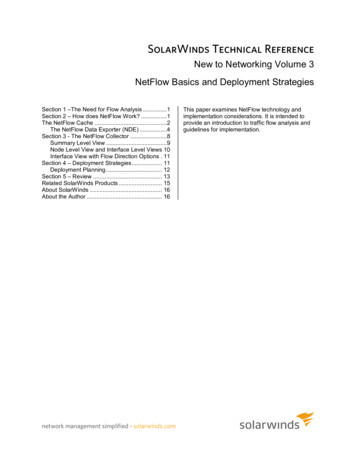
Transcription
SolarWinds Technical ReferenceNew to Networking Volume 3NetFlow Basics and Deployment StrategiesSection 1 –The Need for Flow Analysis .1Section 2 – How does NetFlow Work? .1The NetFlow Cache .2The NetFlow Data Exporter (NDE) .4Section 3 - The NetFlow Collector .8Summary Level View .9Node Level View and Interface Level Views 10Interface View with Flow Direction Options . 11Section 4 – Deployment Strategies . 11Deployment Planning . 12Section 5 – Review . 13Related SolarWinds Products . 15About SolarWinds . 16About the Author . 16network management simplified - solarwinds.comThis paper examines NetFlow technology andimplementation considerations. It is intended toprovide an introduction to traffic flow analysis andguidelines for implementation.
NetFlow Basics andDeployment Strategies2Copyright 1995-2009 SolarWinds. All rights reserved worldwide. No part of this document may be reproduced by any means normodified, decompiled, disassembled, published or distributed, in whole or in part, or translated to any electronic medium or othermeans without the written consent of SolarWinds. All right, title and interest in and to the software and documentation are and shallremain the exclusive property of SolarWinds and its licensors. SolarWinds Orion , SolarWinds Cirrus , and SolarWinds Toolset are trademarks of SolarWinds and SolarWinds.net and the SolarWinds logo are registered trademarks of SolarWinds All othertrademarks contained in this document and in the Software are the property of their respective owners.SOLARWINDS DISCLAIMS ALL WARRANTIES, CONDITIONS OR OTHER TERMS, EXPRESS OR IMPLIED, STATUTORY OROTHERWISE, ON SOFTWARE AND DOCUMENTATION FURNISHED HEREUNDER INCLUDING WITHOUT LIMITATION THEWARRANTIES OF DESIGN, MERCHANTABILITY OR FITNESS FOR A PARTICULAR PURPOSE AND NONINFRINGEMENT. INNO EVENT SHALL SOLARWINDS, ITS SUPPLIERS OR ITS LICENSORS BE LIABLE FOR ANY DAMAGES, WHETHERARISING IN TORT, CONTRACT OR ANY OTHER LEGAL THEORY EVEN IF SOLARWINDS HAS BEEN ADVISED OF THEPOSSIBILITY OF SUCH DAMAGES.Document Revised: 10/30/2009network management simplified - solarwinds.com
NetFlow Basics and Deployment Strategies 1Section 1 –The Need for Flow AnalysisIn general, Network Management Systems (NMS) perform a couple of basic functions – They tell youwhen something has failed and they tell you when something is overloaded. Most of the features of anNMS revolve around providing this information in different formats such as reports, alerts, Syslog viewers,trap viewers, et cetera etc. They answer the questions what happened and when. But when the issue isperformance based, there is very little information to answer the why questions, especially with asaturated WAN link, one of the most common performance issues.As a Network Management Engineer, one will eventually get the call – “Users in site X are complainingthe network is slow.” Using an NMS you might find that the link between site X and the headquarters issaturated. You could have received a couple of text messages or pages from the NMS telling you whenthe link became saturated. The problem is you don’t know why the link is saturated. If you could see whattype of traffic is using the link, you could see what is causing it. That is what NetFlow, and other relatedflow analysis protocols do, they capture information about the nature of the flows.Before NetFlow was around, there were some very cumbersome ways to do this such as placing Y cableson WAN connections allowing a special protocol analyzer appliance to be connected when a link showedunusual behavior. This was expensive, required extra hardware and the results were hard to decipher. Anew technology called RMON came about where a protocol analyzing agent was embedded in networkequipment. The problem with RMON was that it only applied to LAN connections and bandwidth issueshappen much more frequently on the WAN. RMON2 was an improvement as it added fields for networkand application layer monitoring as well as support for WAN technologies. Cisco then launched NetFlowand being that Cisco has such a great share of the internetworking equipment market, NetFlow fairlyquickly became the defacto standard.With an NMS and Netflow deployed you are able to see “what” - a link has became saturated, “when” –the time the problem began and “why” – the nature of the traffic on the link. We’ll see why I call it thenature of the traffic in the next section.For the purpose of this paper, I’ll focus on NetFlow but I’ll also point out the differences and similaritieswith other flow monitoring technologies as appropriate.Section 2 – How does NetFlow Work?The term NetFlow is often used interchangeably between the three major components of NetFlowtechnology, the NetFlow cache and the NetFlow exporter on the router or switch, and the NetFlowcollector used to analyze the flow information. The NetFlow cache is the active monitoring of traffic andonly exists on a NetFlow enabled device. The NetFlow exporter involves sending completed flowinformation from the device to a NetFlow collector, such as Orion NetFlow Traffic Analyzer.Here’s what is happening step-wise: Users in the remote office are accessing the information from the corporate servers and the Internet.In NetFlow terminology, the machines participating in a flow are known as endpoints. As the users’ data flows into R2’s WAN interface, the NetFlow ingress cache is making records aboutthe flows and saving them in R2’s memory. As flows expire (we’ll cover how that happens later) R2’s NetFlow exporter sends the expired flowinformation to the NetFlow collector. The NetFlow collector stores and presents information about user flows.network management simplified - solarwinds.com
NetFlow Basics and Deployment Strategies 2Here is what the whole thing looks like graphically in a much simplified environment.This might seem simple a first glance but there is a lot going on to make all this work. To best understandall the moving pieces we’ll examine the NetFlow cache first, and then look at the exporter and collector.The NetFlow CacheEverything in NetFlow begins with the flow cache. The cache has a couple of basic jobs to do: Interrogate data headers and either mark it as a new flow or add to part of an existing flow. Keep track of flow timers and other factors. When a flow is complete, send it to the exporter, if oneexists, and delete flow information from the device. This process is known as flow aging.The NetFlow cache only keeps information on current or non-expired flows. This brings up an excellentquestion. What constitutes a flow and how does a flow expire? NetFlow v5 is the most common version inuse so we’ll take a look at the v5 flow format. As data enters the NetFlow enabled interface, the IP headeris examined and flows are defined as having values that match the following 7 key fields uniquely: Source IP address. Destination IP address. Source port number. Destination port number Layer 3 protocol type ToS byte value The IfIndex number, also called the logical interface numberWhen a packet enters the NetFlow enabled interface and all seven of these key fields match anexisting flow, it is not considered a new flow but part of the existing flow. If any part of the seven keyfields doesn’t exactly match an existing flow, it is then a new flow and a new flow record is created.network management simplified - solarwinds.com
NetFlow Basics and Deployment Strategies 3Consider the below table of active flows in a cache.Key FieldFlow 1Flow 2Flow 3Flow 4Source IP10.10.1.110.10.1.110.10.2.110.10.3.35Destination IP10.10.2.5510.1.23.110.10.2.25310.10.2.23Source port21808021443Destination ex1111Notice that these are all unique, as none of them duplicate any of the other in all seven key fields. Nowconsider a new IP packet enters the NetFlow interface with the following fields: Source IP 10.10.2.1 Destination IP 10.10.2.253 Source port 21 Destination port 21 Protocol 17 ToS 184 IfIndex 1Because all seven key fields match Flow 3 exactly, a new flow record is not created and information inthis packet header is added to the Flow 3 record. But what information is added to flow 3 if all the fieldsmatch? The matching fields above are the key fields. NetFlow v5 records also contain non-key fields.These non-key fields are stored in the flow record and these counters are updated when packets of anexisting flow are detected. The non-key fields include: Bytes Packets Output interface IfIndex Flow start and finish time Next hop IP Network masks TCP flags Source and destination BGP AS numbersNote that some of these non-key fields come from the new packet and some are achieved by flow cachecalculations, for example the flow start and finish times. This information cannot be derived from a field inthe packet but is a function of the cache marking the time the first packet is seen in a flow and the timethe flow expired.network management simplified - solarwinds.com
NetFlow Basics and Deployment Strategies 4Let’s look at the NetFlow cache on R2’s WAN interface using show ip cache verbose flow command.Seeing as this is an introduction to NetFlow, I won’t go into each field in detail but notice there are foursections to the flow cache display: Packet size distribution. Cache statistics and status. Protocol distribution. Active flow records.The cache output can be a valuable realtime trouble shooting tool. The problem is that the output is notpresented in the most readable of formats and the data tends to move quickly, as it is realtime. One thingyou don’t see in the flow information is any of the payload data, the application information the user ordevice is sending. NetFlow never looks into the payload, so it can’t determine anything past layer 4information. Therefore the information NetFlow gathers tells us about the type or nature of the traffic asinterpreted from the IP header.Using the default settings in NetFlow, all IP packets are interrogated and recorded. There are settingsavailable to use a sampling algorithm but this is rarely implemented. S-flow uses sampled flow collectionby either statistical random sampling or by timer-based sampling, depending on the configuration applied.The NetFlow Data Exporter (NDE)NetFlow devices have a limited amount of memory to store flow information, so at some point the devicehas to make room for new flows. This is where flow aging and exporting comes into play. The NetFlowenabled device keeps track of several factors regarding the flows and the status of the cache itself. Hereare the factors the device uses to age flows and either delete them or export to a collector then delete.These are listed in order of precedence. Cache maximum size is reached. A TCP connection has been terminated by a RST (reset) or FIN (finish) flag in the flow. An active flow timer or inactive flow timer limit is reached.network management simplified - solarwinds.com
NetFlow Basics and Deployment Strategies 5The NetFlow cache size is configurable on most Cisco high-end routers up to 524,288 entries. Each entryuses a minimum of 64 bytes of memory. Once the cache maximum is reached, the device exports usingnew rules to lower the cache count as quickly as possible. This process will export flows when none ofthe other mentioned export triggers have been reached.By definition, when an RST or FIN flag are set in a TCP connection the connection is closed. The Netflowdevice will export any flow when one of these flags is detected.The last in order of precedence are the flow timers. The active flow timer tracks the first packet of all flowsand exports the flow, if it is still active after 30 minutes (default setting) of active flow time. The inactiveflow timer marks the time the last packet in a flow was added. If a new packet in an existing flow isdetected, the timer is reset. If no new packets in a flow are detected within 15 seconds (also default) ofthe last packet, the flow is exported. So, the router is examining flow keys for each packet received,updating active flows or starting a new flow record, keeping a start timer on every flow and updating theactive timer on each packet in a flow. Get that thing an extra cooling fan!Keep in mind that what I have described here is the NetFlow v5 export format.Let’s take a look at a section of the network diagram we saw earlier. Here we’ll focus on the NetFlowcache and exporter on R2 as well as the exported flows going to the collector.We saw an active NetFlow cache in the previous section. Now, we’ll look at an exporter configuration andexamine some packets sent from the exporter.Here is the configuration of our exporter.network management simplified - solarwinds.com
NetFlow Basics and Deployment Strategies 6And here is the resulting export as capture by a protocol analyzer at the second IP address of the“Exporting flows to ” line.What we are seeing in the packet capture is the raw data as it comes into a NetFlow collector. Note thatthe destination IP address in the packet capture is the second IP address listed in the “Exporting flowsto ” line of the telnet session. The source of the packet capture is the interface on the NetFlow routersending flows to our protocol analyzer. The show ip flow interface command shows us that theFastEthernet0/0 is configured to collect only inbound (ingress) flows while the FastEthernet0/1 interface isconfigured to collect inbound and outbound flows. The exporter groups multiple flow records as ProtocolData Units (PDUs) together to reduce the total protocol overhead of exporting. The exporter will place upto 30 PDU’s in a single export. This is seen above as each export packet has 30 flows.Here is the lower protocol section with the Cisco NetFlow/IPFIX layer expanded.network management simplified - solarwinds.com
NetFlow Basics and Deployment Strategies 7Above we see the individual flows represented as PDU’s and with further expansion below, we can seethe information in a single flow record.Notice that the seven key fields (Source and destination IP and ports, protocol, ToS, and input interfaceindex number) are present (they define A flow!). The rest are all non-key information.Remember our goal with NetFlow is to determine who and what is using the bandwidth. Examining theabove capture we see that the who is the machine at the source IP address, 10.199.5.21, which could beresolved to a machine name with DNS. The what is given in the source port line and the protocol line, port161(SNMP) over protocol 17 (UDP). Given that there are 54 packets in this flow in less than 9 secondswe can deduce that this is most likely automated SNMP requests or some mad typing skills! This is onlyone out of thirty flow records in this capture containing 29 exports over about a 15 second period. This isa whole lot of information in a short period of time – certainly more than a human could consume andunderstand in such a short amount of time. This is where the NetFlow Collector comes in. Before we lookat the collector, it is worth pointing out that other versions of NetFlow can use other timers and exportmechanisms. Here is a brief description of the other NetFlow versions: V1 – AKA the router killer. It is still out there on very old equipment. V2 to V4 – Development versions only, not released. V6 - Created to meet a single customer’s needs but no longer supported. (There must be some goodstories behind that one!) V7 – Catalyst-specific export V8 – Allows for the router to preprocess flow information before sending to the collector thus reducingthe export traffic. This version is designed for very high throughput Service Provider devices and isnot widely used. Unless the NetFlow data is being used for accounting, sampling in preferred. V9 – Quickly becoming the new standard. Using flow templates, v9 implements flexibility into thedefinitions of key and non-key fields in a flow. This means that when a new definition of a flow or anew set of key or non-key fields is needed, it is not necessary to create a new NetFlow version.Flexible NetFlow! V10 – IETF standard based flow analysis - IP Flow Information Export or IPFIX. This standard isbased on the NetFlow v9 export format.network management simplified - solarwinds.com
NetFlow Basics and Deployment Strategies 8Section 3 - The NetFlow CollectorThe collector has three main tasks, very similar to an NMS but using different data gathering methods.These are: Receive the flows as they are sent from exporters. Store and aggregate the data. Present the data.In section 2 we saw a capture of 29 v5 exports, each carrying 30 flow records in about 15 seconds. Thisequates to a flow rate of 58 flows per seconds (fps), which is considered low. On a mid-sized network wemight have 50 or so flow exporters. Assuming the same flow rate from each we now have 2900 fps. Flowrates in large networks are measured in tens of thousands of flows per second. Flow rates vary constantlydepending on the number of active user connections detected by the cache.The collector listens on a port (UDP 2055 in our example) for flows from multiple sources. The collectoraggregates information received from the exporters, depending on the time frame requested by the user,using key and non-key fields similar to those used in the cache. So, flows can be aggregated twice, onceby the cache and once by the collector.Now we’ll take a look at some sample output from my favorite collector, SolarWinds Orion Netflow TrafficAnalyzer (NTA).network management simplified - solarwinds.com
NetFlow Basics and Deployment Strategies 9In the above NTA screen we see two resources, one for the endpoint details for the Orion NPM/NTA(10.110.66.98) and one for the Top 25 conversations involving the Orion NPM/NTA endpoint. These areconversations between 10.110.66.98 other endpoints over the last 15 minutes, as indicated in the figure.Notice the endpoint at 10.199.5.1 is listed in the top 25 conversations. This is collector’s presentation ofone of the conversation in the NetFlow cache. Separate flows exported to this collector have been storedand aggregated so we can examine these flows when we need to rather than only as they happen. Thisshows us that over the last 15 minutes there has been an aggregated flow conversation containing 16 KBof data and represents 4.67% of the observed traffic.Below are the individual flow records found by drilling down on the highlighted conversation aggregatefrom 10.199.5.1 above.The above screen shots show the flows specifically from the exporter and cache we examined in sections2 and 3. The collector also has the ability to aggregate flow data to show flow analysis for the wholenetwork, individual nodes and interfaces. Below are examples of each of these.Summary Level ViewThis view gives us a breakdown of the types of traffic seen at the network or summary level. Here there isonly one source (exporter) but this level will aggregate data from all sources this collector is listening to.network management simplified - solarwinds.com
NetFlow Basics and Deployment Strategies 10There are more graphs and tables than I can show on a single screen shot. Other items that can be seenat the summary level include: Top N Domains (using DNS and/or NetBIOS resolution of the endpoint IP addresses). Top N IP Address Groups Top N Receivers Top N ToS Search by Application Collector Status NetFlow EventsNode Level View and Interface Level ViewsHere the same types of resources are available, but the data is restricted to all exports from a single noderather than network wide. Similarly
SolarWinds Orion , SolarWinds Cirrus , and SolarWinds Toolset . quickly became the defacto standard. With an NMS and Netflow deployed you are able to see “what” - a link has became s
